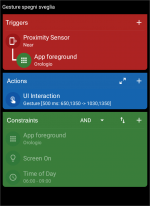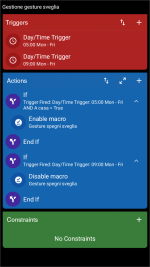Hello,
I have 2 macros, the first one "gesture spegni sveglia" is for not having to swipe exactly on the icon to turn off the alarm clock

and the second one is to turn on and off the first macro, because I have the system log full of "trigger: proximity sensor did not invok because constraint failed".

But in this way I think that the whole process is not battery optimized, having the proximity sensor to work all the time, or at least between the hours specified by the triggers of the second macro.
I have the idea of the first macro that is disabled after one occurence - and then turns on again the day after - but I'm not sure if it's possible and I'm not able to write it so.
Or maybe you have other tips to write these functions in a single and efficient macro...
Thank you, bye
Roberto
I have 2 macros, the first one "gesture spegni sveglia" is for not having to swipe exactly on the icon to turn off the alarm clock

and the second one is to turn on and off the first macro, because I have the system log full of "trigger: proximity sensor did not invok because constraint failed".

But in this way I think that the whole process is not battery optimized, having the proximity sensor to work all the time, or at least between the hours specified by the triggers of the second macro.
I have the idea of the first macro that is disabled after one occurence - and then turns on again the day after - but I'm not sure if it's possible and I'm not able to write it so.
Or maybe you have other tips to write these functions in a single and efficient macro...
Thank you, bye
Roberto
